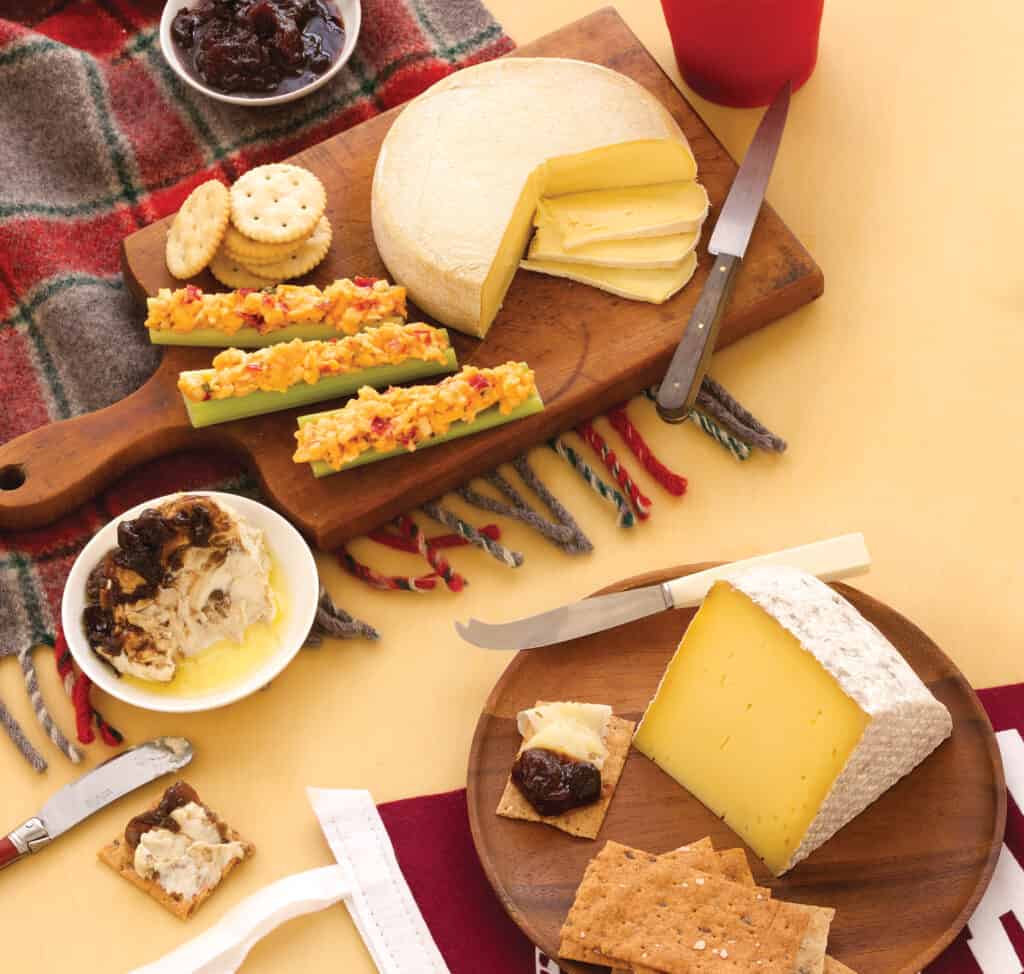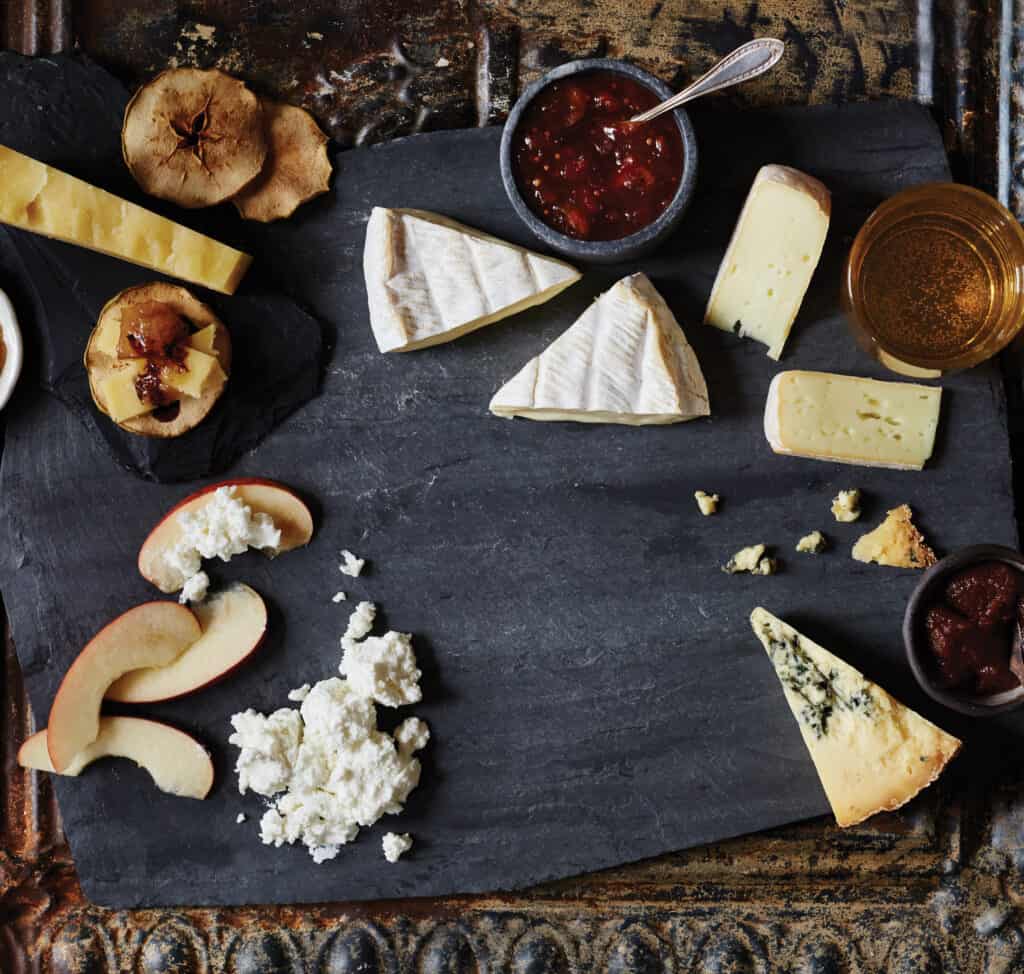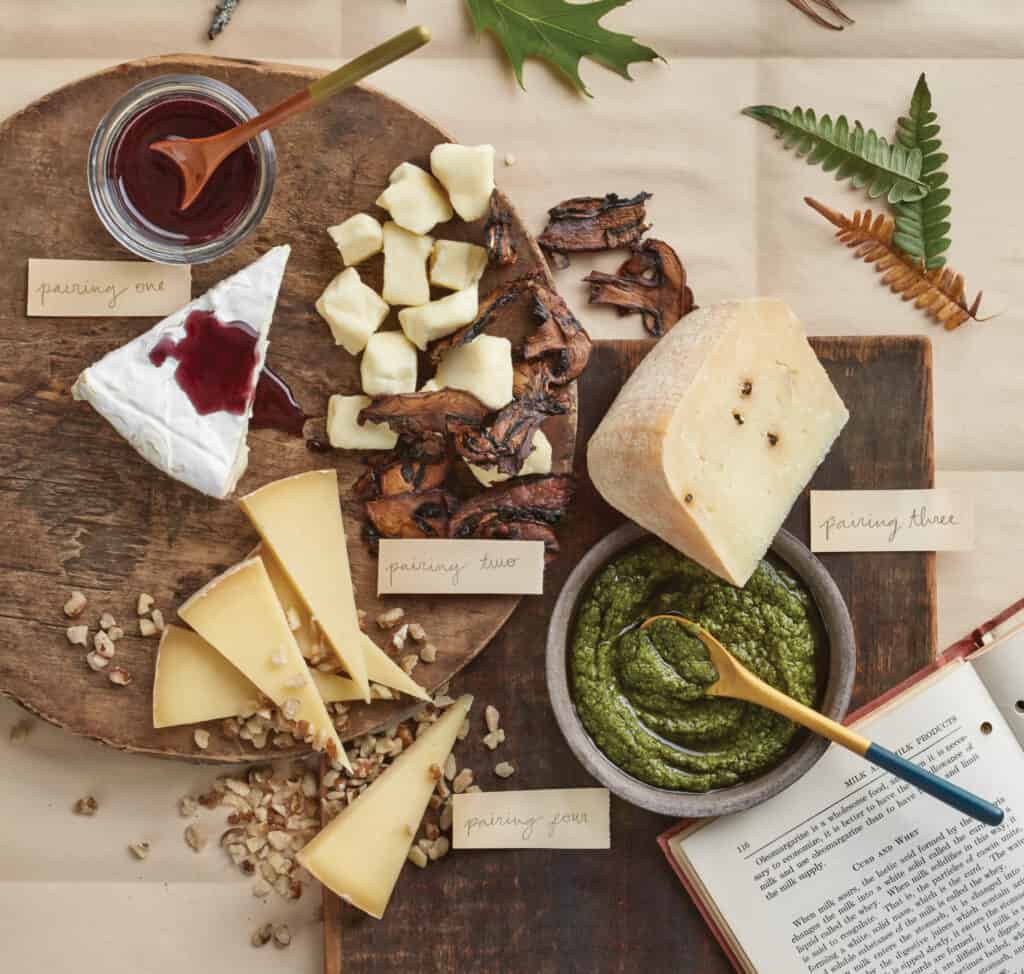These cheese plates will help you savor fall flavors as leaves change and the air turns crisp. Celebrate the the season from creating a cheesy tailgating board or apple themed cheese plate, to foraging food in forests as accompaniments or cozying up with friends enjoying cheese by a warm fire.
Photographed by Mark Ferri | Styled by Leslie Orlandini
Cheesemonger Rickey Little | This article is from: Autumn 2014
When autumn rolls around in Alabama, there’s one thing on everyone’s mind: college football. College football in the South is a way of life (and some might say religion). Fans take their teams—and tailgating—seriously. It’s not uncommon for spectators to roll in to a stadium a week early, set up camp, and start tailgating. But before that happens, the menu must be chosen.
Many customers order custom cheese boards and charcuterie platters from V. Richards Market during college football season. (The majority of them drop off their own boards in advance so we can make it look as if they’ve done the arrangements themselves.) If you’re not having a local monger pick out a selection for you, try these great cheeses and accompaniments from the southeastern United States—and don’t forget to bring lots of ice-cold beer for all the new friends you’re sure to attract.
1. Vidalia Onion & Muscadine Marinated Goat Cheese
Pictured in bowl at left
Stone Hollow Farmstead | Harpersville, Ala.
Goat’s milk; Vegetable rennet
With its combination of sweet caramelized Vidalia onions, tart muscadine syrup, and aged balsamic vinegar, this outstanding fresh chèvre made by Stone Hollow Farmstead simply tastes like the South. It’s awesome smeared on crackers or a fresh baguette.
2. Fiery Pimento Cheese
Pictured on celery at left
Callie’s Charleston Biscuits | North Charleston, S.C.
Cow’s milk
Pimento cheese is a staple across the South. Callie’s makes a drier style than most, using shredded cheddar, pimentos, and spices that give a lasting yet not-too-intense heat. Serve it the traditional way, on either saltine crackers or celery stalks. Pimento cheese need not be any fancier than that.
3. Dancing Fern
Pictured at top center as cut wheel
Sequatchie Cove Farm | Sequatchie, Tenn.
Cow’s milk; Traditional rennet
Soft and slightly oozy, this cheese made with raw milk from primarily Jersey/Holstein cross cattle tastes of rich, cultured butter. Aged 60 days, this Reblochon-style cheese is a consistent award winner, and the best of its type available in the United States, in my opinion.
4. Thomasville Tomme
Pictured at right as a wedge
Sweet Grass Dairy | Thomasville, Ga.
Raw cow’s milk; Traditional rennet
Made in the style of a Pyrenees Tomme, this cheese is smooth and rich, with a tangy and slightly buttery finish. I often notice customers’ eyes open widely as they taste it for the first time. It’s a crowd-pleaser that pairs well with Good People Brewing Co.’s pale ales (made in Birmingham).
ACCOMPANIMENT: Alecia’s Tomato Chutney | Alecia’s Specialty Foods
Alecia’s chutney, made in Leeds, Ala., is a sweet and savory sauce that can be used on literally everything. It’s great with cheeses, but it’s also perfectly at home with any protein off the grill.
Photographed by Evi Abeler | Styled by Laura Knoop
Courtney Hollands | This article is from: Autumn 2015
Sheri LaVigne’s love of dairy stems from her childhood spent on a small farm near Albuquerque, N.M. “We had one goat that provided milk for drinking and making butter, fresh cheese, and ice cream,” she says. “I knew how to milk her before I knew how to tie my shoes.” LaVigne headed east to New York for art school and also traveled to France, sampling stinky cheese for the first time. In 2005, she moved to Seattle, where she couldn’t find anything quite like the store she had frequented in Brooklyn: the Bedford Cheese Shop.
So LaVigne took matters into her own hands, opening The Calf & Kid in the city’s Capitol Hill neighborhood in 2010. To toast the season—and to celebrate the shop’s fifth anniversary and the pending debut of her cheese bar, Culture Club—we asked LaVigne to assemble a pleasing plate of cheeses that play well with Washington’s top crop, apples.
“We have almost all varieties available here year-round,” LaVigne says. “We are lucky ponies.” (In fact, the state produces well over half of the apples in the US.) Ahead, the wheels and wedges to serve with fall’s favorite fruit, in all its forms.
1. Moses Sleeper
- Maker: Jasper Hill Farm
- Origin: Greensboro, Vt.
- Milk: Pasteurized cow’s milk
Apple chutney
“I make my own chutney, and it’s heavy on the clove and lemon rind—more savory than sweet,” LaVigne says. She slathers a full wheel of the Vermont stunner with chutney, then bakes it in croissant dough. “It’s the most delicious hot mess this side of the Mississippi,” she says.
2. Rheba
- Maker: Tieton Farm & Creamery
- Origin: Tieton, Wash.
- Milk: Pasteurized sheep’s and goat’s milk
The mixed-milk “Rheba is slightly funky, with a fat, creamy mouthfeel that coats the tongue deliciously,” LaVigne says. “The cider tastes of bittersweet, tart apple and a bit of wood—it’s strong enough to play with the deep, sweet milk of the cheese.”
3. Stichelton
- Maker: Collingthwaite Farm
- Origin: Nottinghamshire, England
- Milk: Raw cow’s milk
LaVigne loves this brash blue, “but it can be a bit too much for some people,” she says. “This sweet, slightly acidic jam works very well to calm down the rich cave-floor notes and heavy mouthfeel of the cheese.”
4. Fresh Chevre
- Maker: Yarmuth Farm Cheese
- Origin: Darrington, Wash.
- Milk: Pasteurized goat’s milk
Braeburn apple slices
“This is the lightest, fluffiest fresh cheese with a perfect balance of tangy and sweet,” LaVigne says. “It naturally has tons of lemon and citrus notes, so it’s perfect for Braeburns, which tend to be a bit heavier and sweeter in flavor. The pairing is simple, but I love it.” Drizzled with raw honey or topped with crumbled bacon-caramel popcorn, the bite is a crowd-pleaser, she adds.
5. Schlossberger
- Maker: Glauser Dairy
- Origin: Steinen, Switzerland
- Milk: Raw cow’s milk
LaVigne accents this pair with a dollop of Sweet Caroline’s Pear Ginger Cardamom Jam and a drop of BeeWorks Farm Nectar (honey-balsamic reduction). “The cheese tastes of deep and heavy caramel, hazelnut, and a bit of cave floor,” she says. “The other elements elevate these flavors and bring out the cheese’s lighter side.”
Photographed by Nina Gallant | Styled by Madison Trapkin
Madison Trapkin | This article is from Autumn 2020
Now more than ever we’re being forced to examine our food sources. Where do you buy your favorite wedge? How are your veggies grown? Who’s your butcher? For many of us, the answer is probably the nearest grocery store. For others, like Tyler Akabane of the Boston-based mushroom delivery service Mushrooms For My Friends, the answer is foraging.
“[Foraging provides] new and different flavors that [aren’t] possible from store-bought foods,” says Akabane. What started as a clever Instagram handle and a friendship with Boston’s original mushroom man, Ben Maleson, has since evolved into hands-on field classes, supplying top-notch restaurants like Somerville-based Tasting Counter with flawless fungi, and the pandemic-friendly food delivery Akabane recently developed. When it comes to finding your own foraged goodies, consult a pro: nature’s bounty can be poisonous (like certain mushrooms, berries, and greens), but the experts will help you get the good stuff. Check your local farmers’ market or specialty food store for wild accompaniments like those below or take advantage of services like Akabane’s mushroom mobile to get hyper-local treats delivered to your door.
1. OLD CHATHAM CREAMERY CLASSIC CAMEMBERT
Origin: Old Chatham, New York
Milk: Raw Sheep and Cow’s Milk
+ ELDERBERRY SYRUP
“Elderberry loves the edges of wetlands,” says Akabane. These not-too-sweet berries grow wild across most of the United States, but he cautions against over picking as they’re a staple for many birds. He likes to turn his foraged elderberries into syrup by boiling with a 50/50 mixture of sugar and water. Drizzle over the slightly sheepy, super buttery Old Chatham Creamery Classic Camembert for a quintessential sweet-and-savory matchup.
2. BIRCHRUN HILLS FARM CHEESE CURD
Origin: Chester Springs, Pennsylvania
Milk: Pasteurized Cow’s Milk
+ MUSHROOM JERKY
Foraging mushrooms can be especially tricky and potentially life-ending if you don’t know what you’re looking for, so source foraged mushrooms from an operation like Mushrooms For My Friends or a local farmer before going the DIY route. “Sometimes you have too much of a good thing and want it to last,” says Akabane. Preserve part of your mushroom haul (meaty varieties like hen-of-the-wood and chanterelles work best) by making veg-friendly jerky—cook in soy, sugar, and garlic, then dehydrate the ‘shrooms until they’re leather-like. Pair with something equally snackable, such as Birchrun Hills Farm Cheese Curds.
3. BELLWETHER FARMS PEPATO
Origin: Sonoma County, CA
Milk: Raw Sheep’s Milk
+ FORAGED GREENS PESTO
Preservation is the name of the game when it comes to pesto; use this preparation method as a way to extend the life of those precious foraged greens. Akabane recommends collecting your leaves in the spring (garlic mustard, dandelion greens or wild chives, but radish and carrot tops work too), blitzing in the food processor with Parmesan, salt, pepper, and plenty of oil, then freezing in an air-tight container until you’re ready to use. Your homemade foraged greens pesto will keep for nine to 12 months when frozen and can be defrosted for autumnal cheese plates and beyond! Amp up the pepper by pairing with Bellweather Farms Pepato.
4. SWEET GRASS DAIRY GRIFFIN
Origin: Thomasville, Georgia
Milk: Raw Cow’s Milk
+ BLACK WALNUTS
Nuts with cheese is a no-brainer, and black walnuts, with their earthy, bold flavor, make a more exciting partner than English walnuts. Even those available commercially are hand-harvested in the wild. If you’re lucky enough to have a tree in your neighborhood, be aware that their exceptionally hard shell makes them literally a tough nut to crack, says Akabane, who has found them at farmers’ markets as cracked pieces in the shell. To complement their intensity, pair them with a hunk of the malty cow’s milk Griffin from Sweet Grass Dairy. The Georgia cheesemakers soak the curds in Terminus Porter from nearby Gate City Brewing to give this cheese its depth.
Photographed by Nina Gallant | Styled by Kendra Smith
Susan Axelrod | This article is from Winter 2022 (Entertaining)
While many kids dream of growing up to be doctor or a firefighter, there’s a reason why you won’t find a cheesemonger outfit among the Halloween costumes at the big box store: people in the cheese world often come to it from an entirely different profession. Jenn Mason was working in consumer research for enterprise companies, looking for a way to transition her skills to something more fulfilling when she hosted a wine and cheese tasting party for her 45th birthday. The party had a competitive twist: guests were tasked with creating pairings and presenting them to her. “We had people doing it in Yiddish, and Irish brogue, and like a Saturday Night Live skit—I ended up having the most amazing evening of my life,” Mason says.
The party was the push she needed. After extensive research and a weekend at the Cheese School of San Francisco, she opened her now five-year-old cheese shop, Curds and Co., in the Boston suburb of Brookline, Massachusetts. Six months later, she launched Curdbox, which offers a monthly subscription box with cheeses and pairings, accompanied by a tasting guide, a Spotify playlist and an “eat-along” podcast featuring Mason and her friend, artist Julie Fei-Fan Balzer. Most recently she introduced Boards and Co., a free, interactive online resource where anyone can learn about cheese, pairing, and board building. “We’ve taken everything we’ve learned over the last five years and made it really accessible,” she says. “It’s written in language that the everyday customer can understand, and it was never dumbed down.”
The first step on Boards and Co. is to take a quiz to learn your “cheese board personality.” There are seven, each with its own spokesperson and avatar; for example, Cleo is “The Maximalist” and Jackson is “The Artist.” Mason and her team have also renamed the traditional cheese categories to make them more approachable. Cooked and pressed cheeses are “smooth and melty,” cheddar and gouda are “friendly and flexible,” and “bloomy and brainy” are the bries and geotrichum-rind cheeses. Each category is similarly tagged with the flavor profiles that make good pairings. “It’s like mix and match,” she says. “You can pick your cheese and it will say it goes with sweet, salty, and sour, and then you can go to the shelves, where everything is labeled accordingly. We want everyone to walk out feeling like a genius.”
Pairings and experimenting with confidence are at the heart of Mason’s business. “We want cheese to be accessible and some cheeses need a partner to be accessible,” she says. “That’s why it’s Curds ‘and’ Co.; it’s cheese and the company it keeps.” Mason and her team created the following pairings, which are themed “Citrus and Spice.”
1 FROMAGER D’AFFINOIS FLORETTE Origin: Pélussin, France Milk: Pasteurized goat
+ CRAIZE PLANTAIN CRACKERS
The wrinkly-rind goat milk member of this family of easy-to-love cheeses “is like the sequel of a movie that’s actually better than the original,” says Mason. Craize’s gluten-free crackers are sturdy enough to spread on, and their sweet-salty profile is an ideal match for the lemony tang of the cheese.
2 CHIRIBOGA BLUE Origin: Bavaria, Germany Milk: Pasteurized cow
+ LARK MEXICAN CHOCOLATE CHA-CHAS
Made by Ecuadoran native Arturo Chiriboga, this creamy blue is a gateway cheese, says Mason. “If you like butter but you think you don’t like blue cheese, this is how we’re going to get you to like blue cheese.” Slathered on a dark chocolate cookie with a hint of chili “takes it up a notch,” she says. “You feel like the grownup your mother wanted you to be when you eat this pairing.”
3 JASPER HILL FARM WILLOUGHBY Origin: Greensboro, VT Milk: Pasteurized cow
+ ALMOND BROTHERS LEMON ROASTED ALMONDS
This washed-rind wheel with a complex, earthy flavor near the rind and a milder, fruity interior is for lovers of funk. “Or, if you don’t like funky you can just eat the inside,” says Mason. She pairs the gooey cheese with startlingly lemony roasted almonds, a customer favorite, which “tastes like Fruity Pebbles in the best possible way.”
4 WILDE WEIDE Origin: South Holland, Netherlands Milk: Raw cow
+ BRINS LEMON SAFFRON MARMALADE
Produced on a lake island, this traditional farmhouse gouda is bright and grassy, with warm, bourbon-y back notes. “We’re playing off that brightness with small-batch Brins marmalade; the saffron takes the edge off the lemon and the sweetness to give it undertones of honey that goes great with the cheese” says Mason.
5 HAY FLOWER REBEL Origin: Austria Milk: Raw cow
+ HLTHPUNK HARISSA CHILI PASTE
Hay milk and a dried flower–coated rind gives this “smooth and melty” Alpine cheese sweet notes of honey and meadow grasses. Mason likes to pair it with spicy, smoky, vegan harissa—packaged in HLTHPUNK’s handy tube—on a baguette or in an elevated grilled cheese.
Mallory Scyphers
Mallory Scyphers is culture's Executive Content Director and has been with the company since 2018. She lives on Mobile Bay with her husband, two young daughters, one rambunctious golden retriever, and two loyal cats. Her favorite cheeses are alpine styles and mineral-y blues.








